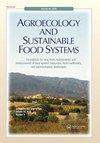研究了嗜冷微藻和蓝藻多糖的提取工艺、定量得率及抗氧化活性
IF 2.6
3区 农林科学
Q1 AGRICULTURE, MULTIDISCIPLINARY
Agroecology and Sustainable Food Systems
Pub Date : 2023-07-13
DOI:10.21323/2618-9771-2023-6-2-202-210
引用次数: 0
摘要
胞外多糖和胞内多糖是嗜冷微藻和蓝藻抗氧化复合物的主要成分。从细胞中提取这些化合物是非常消耗能量的,而且由于微藻细胞壁的弹性、顽固性、复杂性和多样性,它需要大剂量的化学物质。研究了超声处理功率和提取时间对多糖定量产率的影响,并测定了亲冷微藻和蓝藻的抗氧化复合物的抗氧化活性。为了发现和确认从微观藻类生物量中获得的配合物的抗氧化性能,我们采用了基于测量光密度的方法(在液体营养介质中),即通过研究样品降低自由基水平的能力来确定其抗氧化活性的方法。通过研究,找到了从细胞培养液中提取抗氧化复合物的合理条件,以及从与细胞相关的嗜冷微藻和蓝藻中提取抗氧化复合物的条件,这些蓝藻包括假骨藻、假海藻、kerguelfragilariopsis、Aphanizomenon gracile和水螅。对嗜冷微藻和蓝藻pseudocostatum、Thalassiosira pseudonana、Fragilariopsis kerguelensis、Aphanizomenon gracile和Anabaena ica的胞外多糖的提取,采用乙醇提取法,提取模比为1:2,提取温度为5°С。研究了嗜冷微藻和蓝藻:假腹骨藻、假海藻、克格尔碎藻、瘦弱单胞菌和白茅水藻产生抗氧化复合物的能力。发现该复合物含有多糖,特别是内多糖和外多糖。通过ABTS、DPPH和FRAP方法测定并证实了嗜冷微藻和蓝藻的显著抗氧化活性,证明了嗜冷微藻和蓝藻产生抗氧化复合物的能力。嗜冷微藻假肋骨藻具有最高的抗氧化活性。在嗜冷微藻和蓝藻中抗氧化性能的可用性为其实际应用开辟了前景。本文章由计算机程序翻译,如有差异,请以英文原文为准。
Study of extraction parameters, quantitative yield of polysaccharides and antioxidant activity of psychrophilic microalgae and cyanobacteria
Exopolysaccharides and endopolysaccharides are the main components in the antioxidant complex of psychrophilic microalgae and cyanobacteria. The extraction of these compounds from the cells is really energy consuming, as well as it requires large doses of chemicals due to the resilience, recalcitrance, complexity and diversity of the cell wall in microalgae. The purpose of this article was to study the dependence of polysaccharides quantitative yield on the power of ultrasound treatment and duration of their extraction, as well as to determine the antioxidant activity of the antioxidant complex of psychrophilic microalgae and cyanobacteria. In order to find and confirm the antioxidant properties of the complexes obtained from the microscopic algae biomass, we used the method based on measuring the optical density (in a liquid nutrient medium), i. e. the method for determining the antioxidant activity of the samples under research by their ability to reduce the level of free radicals. As a result of the studies the rational conditions were found for the extraction of the antioxidant complex from the cell culture fluid, and from the cell-related psychrophilic microalgae and cyanobacteria Skeletonema pseudocostatum, Thalassiosira pseudonana, Fragilariopsis kerguelensis, Aphanizomenon gracile, and Anabaena cylindrica. For the exopolysaccharides extraction from the psychrophilic microalgae and cyanobacteria Skeletonema pseudocostatum, Thalassiosira pseudonana, Fragilariopsis kerguelensis, Aphanizomenon gracile and Anabaena cylindrica, the method of ethanol extraction with an extraction module of 1:2 and an extraction temperature of 5 °С was used. The ability of psychrophilic microalgae and cyanobacteria Skeletonema pseudocostatum, Thalassiosira pseudonana, Fragilariopsis kerguelensis, Aphanizomenon gracile and Anabaena cylindrica to produce an antioxidant complex was studied. It was found that this complex contains polysaccharides: endopolysaccharides and exopolysaccharides in particular. The ability of psychrophilic microalgae and cyanobacteria Skeletonema pseudocostatum, Thalassiosira pseudonana, Fragilariopsis kerguelensis, Aphanizomenon gracile, and Anabaena cylindrica to produce an antioxidant complex was proven by the presence of significant antioxidant activity of psychrophilic microalgae and cyanobacteria, determined and confirmed by the methods ABTS, DPPH, and FRAP. The psychrophilic microalga Skeletonema pseudocostatum possesses the highest antioxidant activity. The availability of antioxidant properties in psychrophilic microalgae and cyanobacteria opens up the prospects for their practical application.
求助全文
通过发布文献求助,成功后即可免费获取论文全文。
去求助
来源期刊

Agroecology and Sustainable Food Systems
AGRICULTURE, MULTIDISCIPLINARY-GREEN & SUSTAINABLE SCIENCE & TECHNOLOGY
CiteScore
4.80
自引率
7.70%
发文量
73
期刊介绍:
Agroecology and Sustainable Food Systems is devoted to the rapidly emerging fields of agroecology and food system sustainability. By linking scientific inquiry and productive practice with transformative social action, agroecology provides a foundation for developing the alternative food systems of the future. The journal focuses on the changes that need to occur in the design and management of our food systems in order to balance natural resource use and environmental protection with the needs of production, economic viability, food security, and the social well-being of all people.
Agroecology and Sustainable Food Systems examines our current food systems from production to consumption, and the urgent need to transition to long-term sustainability. The journal promotes the study and application of agroecology for developing alternatives to the complex problems of resource depletion, environmental degradation, a narrowing of agrobiodiversity, continued world hunger, consolidation and industrialization of the food system, climate change, and the loss of farm land. The journal uses a food systems approach, and seeks experiences in agroecology that are on-farm, participatory, change-oriented, and backed by broad-based methodologies of sustainability analysis and evaluation.
 求助内容:
求助内容: 应助结果提醒方式:
应助结果提醒方式:


